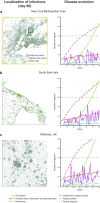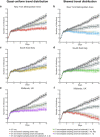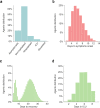This is a preprint.
Containment of future waves of COVID-19: simulating the impact of different policies and testing capacities for contact tracing, testing, and isolation
- PMID: 32577688
- PMCID: PMC7302294
- DOI: 10.1101/2020.06.05.20123372
Containment of future waves of COVID-19: simulating the impact of different policies and testing capacities for contact tracing, testing, and isolation
Update in
-
Containment of COVID-19: Simulating the impact of different policies and testing capacities for contact tracing, testing, and isolation.PLoS One. 2021 Mar 31;16(3):e0247614. doi: 10.1371/journal.pone.0247614. eCollection 2021. PLoS One. 2021. PMID: 33788852 Free PMC article.
Abstract
We used multi-agent simulations to estimate the testing capacity required to find and isolate a number of infections sufficient to break the chain of transmission of SARS-CoV-2. Depending on the mitigation policies in place, a daily capacity between 0.7 to 3.6 tests per thousand was required to contain the disease. However, if contact tracing and testing efficacy dropped below 60% (e.g. due to false negatives or reduced tracing capability), the number of infections kept growing exponentially, irrespective of any testing capacity. Under these conditions, the population's geographical distribution and travel behaviour could inform sampling policies to aid a successful containment.
Keywords: COVID-19; Coronavirus; SARS-CoV-2; multi-agent simulations; pandemic; second wave.
Conflict of interest statement
Competing Interests statement The authors report no conflict of interest.
Figures




References
-
- World Health Organization - Coronavirus disease (COVID-19) Situation Report - 133. (2020).
Publication types
Grants and funding
LinkOut - more resources
Full Text Sources
Miscellaneous
